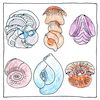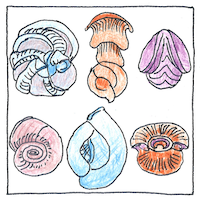John Hogg
protistology

|
Protist
Carl Linnaeus said there were Animalia, Plantae, and a third kingdom Lapides, the rocks. But before there were animals, before there were plants, life existed, reasoned John Hogg, and he called this fourth kingdom Protoctista. Protists are eukaryotic organisms that do not fit into the animal or plant kingdom.
Protests
Protozoa are animal-like unicellular protists— amoeba, flagellata, ciliophora, sporozoans. Protophyta are plant-like protists— thallophytes and unicellular algae. Molds are fungus-like but they are not fungi. Some protists are odd, such as the metamonads, including the retoramonads, diplomonads, and maybe the parabasalids and oxymonads. Are fungi multicellular protists? (Fungi are not animals, plants, or rocks.) Some forms of life are not so easy to classify. Diatoms, are they animals? Are slime molds amoebas? Bacteria are not protists because they are not eukaryotic; they don’t have nuclei or organelles. Viruses and viroids are not protists; some say they are not a form of life.
Like us
Clearly, mammals are like us. After all, we are mammals. Also marsupials and octopi. How about birds and fish? Aren’t they like us? They have backbones like us, hearts and brains, and little brown eyes that look at us. Maybe reptiles? Turtles are cute, and some think dinosaurs were warm-blooded, like us. But I rule out, I categorically rule out mollusks and crabs. I like them, but mainly on my dinner plate. Also worms and insects. Insects and worms are not like us.



Protists are not necessarily related genetically; the kingdom of protists remains a grabbag of misfits, like us.
See also in The book of science:
Readings in wikipedia: